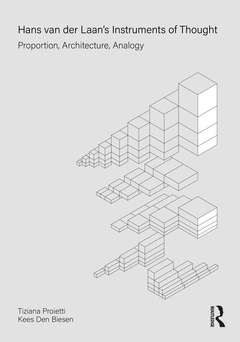Description
Hans van der Laan’s Instruments of Thought
Proportion, Architecture, Analogy
Authors: Proietti Tiziana, Biesen Kees
Language: English
Subject for Hans van der Laan’s Instruments of Thought:
· 17.4x24.6 cm · Paperback
Description
/li>Contents
/li>Readership
/li>Biography
/li>
This triad of deeply interconnected intellectual strategies represents his most important ?instruments of thought? and is rooted in the careful observation of phenomena as they are presented to us rather than relying on conventional beliefs. Van der Laan's instruments of thought lead us to reconsider the origins of human creation, urging a deeper examination of our perceptual and cognitive response to the limitlessness of the surrounding environment. On this basis, Van der Laan develops a unique philosophy of culture and design, that includes considerations on the relationship between nature, culture and religious ritual.
Although this book is informative, its principal aim is to be formative. On the basis of Van der Laan?s instruments of thought, the authors develop a methodology to explore the Plastic Number theory and the many ways in which we perceive and interpret proportion. Reintroducing playful creativity and intellectual exploration into architectural pedagogy and design practice, this book is a gateway for a deeper understanding of the effects of the built environment on human behavior and the various ways in which the human mind perceives and decodes artifacts.
1. Introduction 2. From Things to Thoughts to Understanding 3. From Thoughts to Things to Practice 4. The Great Play of Forms Annex
Tiziana Proietti is an architect, educator and researcher. She is Professor at the C. Gibbs College of Architecture at the University of Oklahoma where she holds joint appointments in the Departments of Architecture and Interior Design. She is director of the Sense Base Laboratory, a hub for interdisciplinary research aimed to bridge neuroscience and architecture and test human response to architectural proportion.
Kees den Biesen is an independent scholar in literature, philosophy and theology, specialized in early Christian literature, architectural theory, and symbolical theology. His main interest is in the interaction between art, thought and religion. He is primarily engaged in publishing in the field of Syriac studies and teaches at the Pontifical Oriental Institute in Rome.




